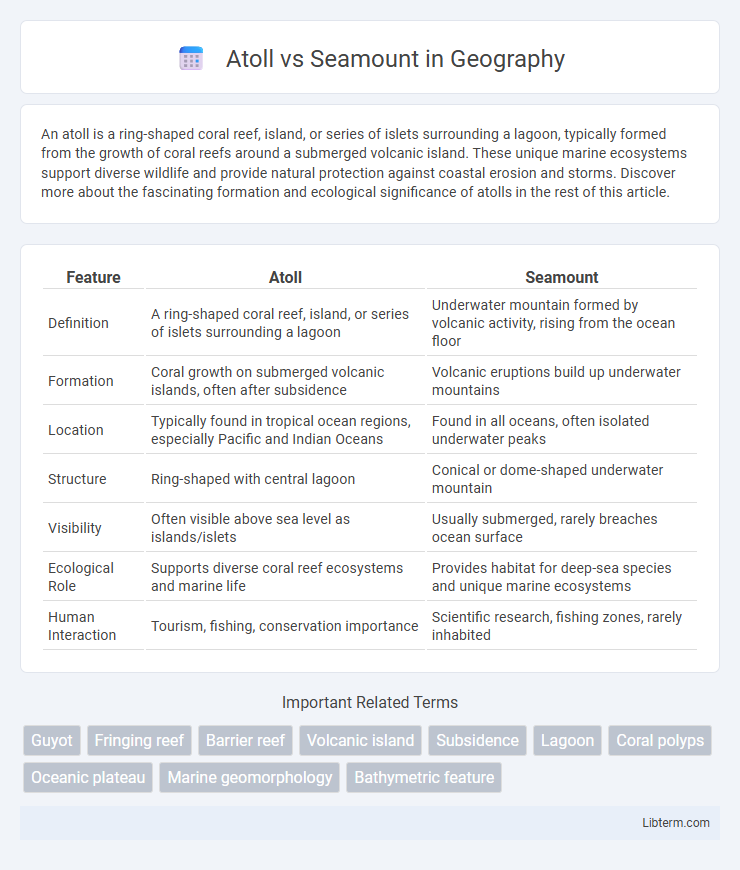An atoll is a ring-shaped coral reef, island, or series of islets surrounding a lagoon, typically formed from the growth of coral reefs around a submerged volcanic island. These unique marine ecosystems support diverse wildlife and provide natural protection against coastal erosion and storms. Discover more about the fascinating formation and ecological significance of atolls in the rest of this article.
Table of Comparison
| Feature | Atoll | Seamount |
|---|---|---|
| Definition | A ring-shaped coral reef, island, or series of islets surrounding a lagoon | Underwater mountain formed by volcanic activity, rising from the ocean floor |
| Formation | Coral growth on submerged volcanic islands, often after subsidence | Volcanic eruptions build up underwater mountains |
| Location | Typically found in tropical ocean regions, especially Pacific and Indian Oceans | Found in all oceans, often isolated underwater peaks |
| Structure | Ring-shaped with central lagoon | Conical or dome-shaped underwater mountain |
| Visibility | Often visible above sea level as islands/islets | Usually submerged, rarely breaches ocean surface |
| Ecological Role | Supports diverse coral reef ecosystems and marine life | Provides habitat for deep-sea species and unique marine ecosystems |
| Human Interaction | Tourism, fishing, conservation importance | Scientific research, fishing zones, rarely inhabited |
Introduction to Atolls and Seamounts
Atolls are ring-shaped coral reefs, islands, or series of islets surrounding a lagoon, typically formed from the subsidence of volcanic islands over millions of years. Seamounts are underwater mountains rising from the ocean floor, usually volcanic in origin, but do not reach the water's surface. Both atolls and seamounts play crucial roles in marine biodiversity and oceanographic processes.
Defining Atolls: Structure and Formation
Atolls are ring-shaped coral reefs that encircle a lagoon, formed from the gradual subsidence of volcanic islands combined with coral growth. The structure consists primarily of limestone deposited by coral polyps, creating a unique marine ecosystem supported by shallow, warm waters. Unlike seamounts, which are underwater volcanic mountains, atolls develop over time through biological and geological processes resulting in their distinctive coral reef formation.
What is a Seamount? Geological Overview
A seamount is an underwater mountain formed by volcanic activity that rises abruptly from the ocean floor but does not reach the water's surface. These geological features are primarily composed of basalt and result from magma erupting through the earth's crust at tectonic plate boundaries or hotspots. Seamounts significantly influence marine biodiversity by creating unique habitats and affecting ocean currents.
Key Differences Between Atolls and Seamounts
Atolls are ring-shaped coral reefs encircling a lagoon, formed from the subsidence of volcanic islands, while seamounts are underwater mountains created by volcanic activity that do not reach the ocean surface. Atolls consist primarily of biological structures made of coral, whereas seamounts are geological features composed mainly of igneous rock. The ecological significance of atolls lies in their role as rich marine habitats, contrasting with seamounts' influence on ocean currents and deep-sea biodiversity hotspots.
Formation Processes: Atolls vs Seamounts
Atolls form through the subsidence of volcanic islands combined with coral reef growth, where coral reefs build up around sinking landmasses, eventually leaving a ring-shaped reef enclosing a lagoon. Seamounts originate from volcanic activity on the ocean floor, forming isolated underwater mountains that do not reach the ocean surface. The key difference lies in atolls being largely biological structures atop subsided volcanoes, while seamounts are purely geological volcanic features rising from the seabed.
Ecological Importance of Atolls
Atolls serve as critical habitats for diverse marine species, supporting coral reefs that maintain high biodiversity and fish populations essential for food security. These ring-shaped coral islands contribute to coastal protection by buffering shorelines against storms and erosion, thus preserving fragile ecosystems. Seamounts, while important for deep-sea biodiversity, lack the extensive shallow-water coral reef systems that are vital in atoll ecosystems for sustaining vibrant marine life and fisheries.
Biodiversity and Marine Life on Seamounts
Seamounts are underwater mountains that serve as biodiversity hotspots by providing unique habitats and nutrient upwellings that support diverse marine life, including various fish species, corals, and invertebrates. Unlike atolls, which are ring-shaped coral reefs surrounding lagoons, seamounts often harbor endemic species adapted to their isolated ecosystems and play critical roles in migratory pathways and spawning grounds. These underwater features contribute significantly to oceanic ecological productivity and are vital for sustaining fisheries and marine biodiversity conservation efforts.
Human Impact on Atolls and Seamounts
Human activities on atolls often lead to habitat degradation through coastal development, pollution, and overfishing, threatening unique biodiversity and traditional livelihoods. Seamounts experience significant impacts from deep-sea mining, trawling, and marine pollution, disrupting fragile ecosystems and species that rely on these underwater mountains. Both environments require stringent conservation measures to mitigate human-induced damage and preserve their ecological integrity.
Atolls and Seamounts in Climate Change Context
Atolls and seamounts play critical roles in marine ecosystems that influence climate regulation, with atolls often acting as natural barriers protecting coastal areas from storm surges intensified by climate change. Seamounts serve as hotspots of marine biodiversity, supporting species that contribute to carbon sequestration through their biological processes. The degradation of atolls due to sea-level rise and ocean acidification, alongside the disturbance of seamount habitats, threatens these natural climate mitigation functions.
Conclusion: Choosing Between Atoll and Seamount Exploration
Atoll exploration offers unique insights into coral reef ecosystems and biodiversity, whereas seamount studies reveal crucial data about underwater volcanic activity and deep-sea habitats. Selection depends on research goals: prioritize atolls for ecological and conservation studies, and seamounts for geological and oceanographic investigations. Understanding the distinct environmental and biological characteristics of each guides optimal resource allocation and scientific outcomes.
Atoll Infographic

 libterm.com
libterm.com